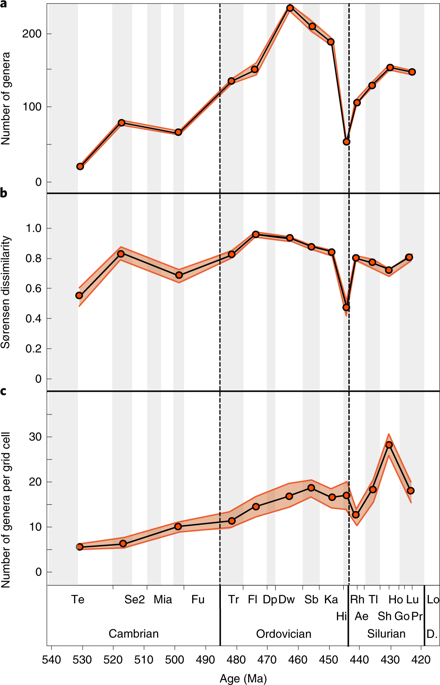当前位置:
X-MOL 学术
›
Nat. Ecol. Evol.
›
论文详情
Our official English website, www.x-mol.net, welcomes your feedback! (Note: you will need to create a separate account there.)
Impacts of spatial and environmental differentiation on early Palaeozoic marine biodiversity.
Nature Ecology & Evolution ( IF 16.8 ) Pub Date : 2019-11-18 , DOI: 10.1038/s41559-019-1035-7 Amelia Penny 1 , Björn Kröger 1
Nature Ecology & Evolution ( IF 16.8 ) Pub Date : 2019-11-18 , DOI: 10.1038/s41559-019-1035-7 Amelia Penny 1 , Björn Kröger 1
Affiliation

|
The unprecedented diversifications in the fossil record of the early Palaeozoic (541-419 million years ago) increased both within-sample (α) and global (γ) diversity, generating considerable ecological complexity. Faunal difference (β diversity), including spatial heterogeneity, is thought to have played a major role in early Palaeozoic marine diversification, although α diversity is the major determinant of γ diversity through the Phanerozoic. Drivers for this Phanerozoic shift from β to α diversity are not yet resolved. Here, we evaluate the impacts of environmental and faunal heterogeneity on diversity patterns using a global spatial grid. We present early Palaeozoic genus-level α, β and γ diversity curves for molluscs, brachiopods, trilobites and echinoderms and compare them with measures of spatial lithological heterogeneity, which is our proxy for environmental heterogeneity. We find that α and β diversity are associated with increased lithological heterogeneity, and that β diversity declines over time while α increases. We suggest that the enhanced dispersal of marine taxa from the Middle Ordovician onwards facilitated increases in α diversity by encouraging the occupation of narrow niches and increasing the prevalence of transient species, simultaneously reducing spatial β diversity. This may have contributed to a shift from β to α diversity as the major determinant of γ diversity increase over this critical evolutionary interval.
中文翻译:

空间和环境差异对早期古生代海洋生物多样性的影响。
早古生代(541-419百万年前)的化石记录中史无前例的多样化增加了样本内(α)和全球(γ)多样性,产生了相当大的生态复杂性。尽管α多样性是古生代中γ多样性的主要决定因素,但人们认为动物的动物差异(β多样性)包括空间异质性在早期古生代海洋多样性中起着重要作用。尚生代从β到α多样性转变的驱动因素尚未解决。在这里,我们使用全球空间网格评估环境和动物异质性对多样性格局的影响。我们提出了软体动物,腕足动物,三叶虫和棘皮动物的古生代属水平的α,β和γ多样性曲线,并将它们与空间岩性异质性的测量结果进行比较,这是我们解决环境异质性的代理。我们发现,α和β多样性与增加的岩性非均质性有关,并且β多样性随着时间的推移而下降,而α则增加。我们建议,从中奥陶纪开始加强海洋生物分类的扩散,通过鼓励占领狭窄的生态位并增加瞬态物种的流行率,同时减少空间β多样性,促进了α多样性的增加。随着γ多样性的主要决定因素在这个关键的进化区间内增加,这可能导致了从β多样性向α多样性的转变。我们建议,从中奥陶纪开始加强海洋生物分类的扩散,通过鼓励占领狭窄的生态位并增加瞬态物种的流行率,同时减少空间β多样性,促进了α多样性的增加。随着γ多样性的主要决定因素在这个关键的进化区间内增加,这可能导致了从β多样性向α多样性的转变。我们建议,从中奥陶纪开始加强海洋生物分类的扩散,通过鼓励占领狭窄的生态位并增加瞬态物种的流行率,同时减少空间β多样性,促进了α多样性的增加。随着γ多样性的主要决定因素在这个关键的进化区间内增加,这可能导致了从β多样性向α多样性的转变。
更新日期:2019-11-18
中文翻译:

空间和环境差异对早期古生代海洋生物多样性的影响。
早古生代(541-419百万年前)的化石记录中史无前例的多样化增加了样本内(α)和全球(γ)多样性,产生了相当大的生态复杂性。尽管α多样性是古生代中γ多样性的主要决定因素,但人们认为动物的动物差异(β多样性)包括空间异质性在早期古生代海洋多样性中起着重要作用。尚生代从β到α多样性转变的驱动因素尚未解决。在这里,我们使用全球空间网格评估环境和动物异质性对多样性格局的影响。我们提出了软体动物,腕足动物,三叶虫和棘皮动物的古生代属水平的α,β和γ多样性曲线,并将它们与空间岩性异质性的测量结果进行比较,这是我们解决环境异质性的代理。我们发现,α和β多样性与增加的岩性非均质性有关,并且β多样性随着时间的推移而下降,而α则增加。我们建议,从中奥陶纪开始加强海洋生物分类的扩散,通过鼓励占领狭窄的生态位并增加瞬态物种的流行率,同时减少空间β多样性,促进了α多样性的增加。随着γ多样性的主要决定因素在这个关键的进化区间内增加,这可能导致了从β多样性向α多样性的转变。我们建议,从中奥陶纪开始加强海洋生物分类的扩散,通过鼓励占领狭窄的生态位并增加瞬态物种的流行率,同时减少空间β多样性,促进了α多样性的增加。随着γ多样性的主要决定因素在这个关键的进化区间内增加,这可能导致了从β多样性向α多样性的转变。我们建议,从中奥陶纪开始加强海洋生物分类的扩散,通过鼓励占领狭窄的生态位并增加瞬态物种的流行率,同时减少空间β多样性,促进了α多样性的增加。随着γ多样性的主要决定因素在这个关键的进化区间内增加,这可能导致了从β多样性向α多样性的转变。


























 京公网安备 11010802027423号
京公网安备 11010802027423号